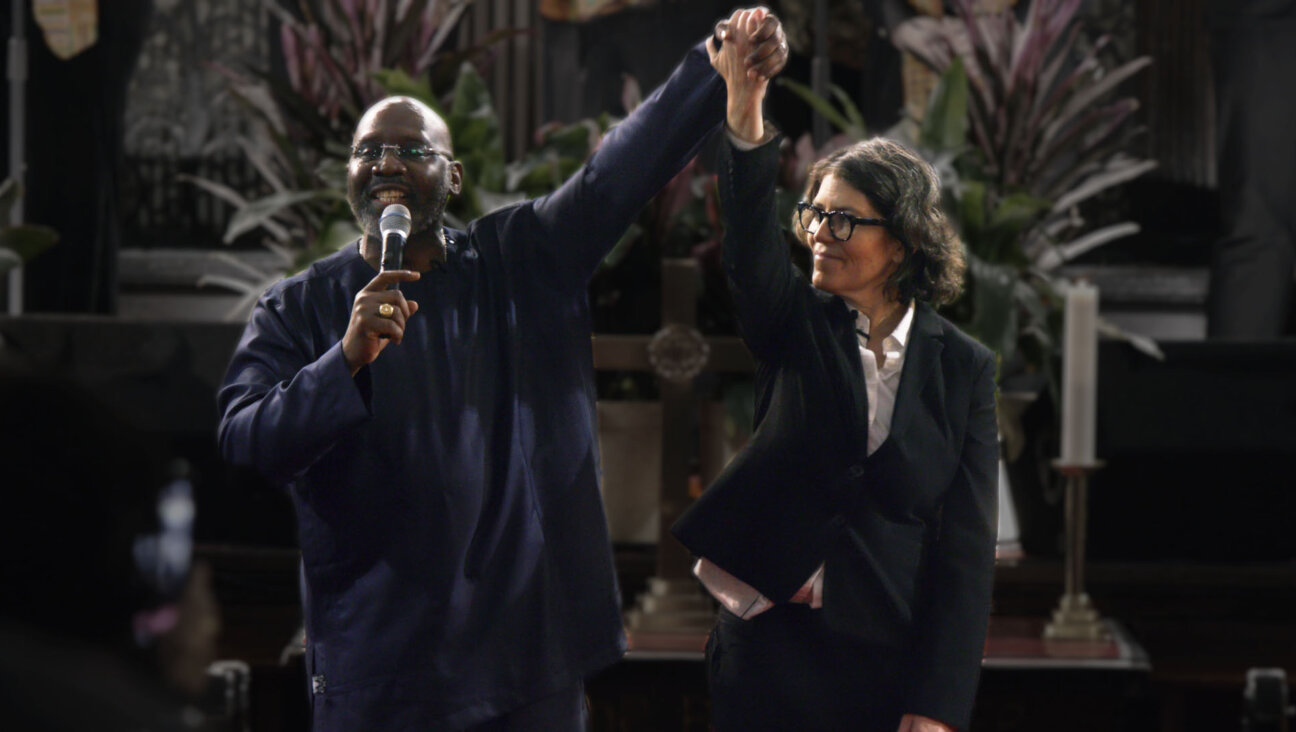‘Bearded Lady’ and ‘Gender Terrorist’ Take Performance Art Beyond the Fringes

Glamming It Up: Jennifer Miller says being Jewish made it possible for her to be a bearded woman who can sport a gown on or offstage. Image by Karl Giant
Stomping across the stage in a disheveled blond wig, cheesy pink boots, and a jean skirt adorned with raccoon tails, performance artist Rose Wood is every bit the trailer-park hooker attempting to sell her wares. Enraged and desperate, she strips off her torn and tied T-shirt, revealing nude breasts, and when that doesn’t work, she drops her panties to display her penis.
It’s 3 a.m. at the Box, a trendy destination spot on the Lower East Side of Manhattan for celebrities and the well-heeled who want to dabble in a little decadence. The dimly lit, tightly packed space, with its frayed, heavy wall hangings, is at once 19th-century opera house and punk rock club, with a hint of goth thrown in for good measure. Wood is one of many provocative performers, but undoubtedly the main attraction and a nightly staple at the Box since 2006.
It’s far-out theater and not for all tastes, admits Wood, who was born Jon Moskowitz and defines herself as a “gender-terrorist.” In short-form snippets that run the gamut of sensibilities — from hypersexual and brutish to joyous and demented — Wood uses the stage to offer social commentary on a range of issues, most pointedly the myths and hypocrisy surrounding gender identity.
Wood can play straight men or straight women and “pass” as either, but more often than not she tackles sexually ambiguous characters, including a Rabbi Rosenwood who takes to the stage on Jewish holidays. Burlesque, vaudeville, drag, and political theater have shaped Wood’s wordless performance, which is explicit and at times grisly.
“Terms like ‘pornographic’ or ‘exhibitionistic’ or ‘aggressive’ are social constructs,” says the heady, yet very gentle offstage Wood who meets with me in her overstuffed Chelsea workshop where she works as a high-end wood refinisher. “That’s not to say there is no such thing as pornographic or exhibitionistic or aggressive,” she continues, “but it all has to do with the intention. Someone who is administering the Heimlich maneuver is aggressive.”
Wood seeks to shake her audience out of their comfort zone and, in so doing, free them to get up and dance and intermingle between sets. She also sees herself as a teacher who, ideally, broadens their perspectives by “opening up that part of me that I would hide or repress — or that others might judge — in order to reveal something that’s universal.”
There’s a political dynamic involved as well. “Because I work in a space for a privileged elite who have paid $1,500 to $2,500 for a table, my role is to enhance their sense of entitlement by making them feel superior because they’re seeing something naughty others are not seeing.”
Off stage Wood evokes a masculine figure despite the coiffed wig and deftly applied eyeliner. She walks around her studio with large strides, devoid of campiness. She was never a gay man and she’s not fully trans either, though she has always felt more like a woman than a man. Asked why she calls herself “Rose Wood,” she explains that the name was inspired by the beautiful rosewood she works on in her shop, and proudly holds up a polished reddish-brown slab. “Ebony is the king of woods, while rosewood is the queen of wood,” she says.
Still, Wood still struggles with her gender identity. She is not sexually drawn to men, women, transmen or transwomen, though she had a short-lived period of drugged-out, polymorphic sexual activity a long time ago. “And now I could care even less,” she notes matter-of-factly.
Following a stint as a pre-med student at NYU, Wood launched her career as a drag queen, moved on to burlesque (during which time she was a member of the music and comedy group Nice Jewish Girls Gone Bad), and finally morphed into her current incarnation as an edgy performance artist.
Her growth as a performer evolved with her physical transformation, which involved getting breast implants to replace the prosthetic boobs she previously used. More recently, Wood has endured facial work, shaving her jaw and reconstructing her forehead to make her appear more female. Lifting her wig she reveals a scar etched across the top of her scalp. “It’s a softening, a feminization,” she says.
Wood concedes that her mixed gender identity has theatrical traction onstage, which influenced her decision to go under the knife, but she states that the surgery was not simply a career move — life on and offstage are deeply interrelated for her. “Anyone can have a hole put in his body,” she says. “Not everyone can live as two genders. My surgery is about gender, not body modification. I don’t do piercings or tattoos. Jews don’t do piercings or tattoos.”
Growing up in middle-class, suburban Somerville, N.J., whose Jewish population was less than 10 percent, Wood had a sense of “otherness” early on, she recalls. “I had anti-Semitic experiences. So prior to anyone saying, ‘you’re strange,’ ‘you’re weird,’ I felt like an underdog because I was a Jew.”
Wood’s Jewishness informs her aesthetic whether or not she’s playing her rabbi character. Whatever her onstage alter ego, Judaism places a positive emphasis on sexuality, she insists, noting that Orthodox Jews are expected to have sex on Shabbos. “It’s a celebration and mitzvah.”
No character is more joyous than her inebriated Rabbi Rosenwood, who dances about, strips and masturbates to the music of “L’chaim,” and finally rips off a tallit worn like a shawl to reveal an abundant bosom. The rabbi’s prayers and blessings overshadow all perversities, contends Wood. “Spirituality is as present as the gender split.”
Not everyone appreciates her performances. Wood has been pelted with ice, booed and worse. Recently, she says, a Muslim Saudi prince who arrived at the Box with an entourage and dropped thousands of dollars was offended by Wood’s performance and insisted that she be removed from the show. The management refused, and ultimately the prince came around to viewing the performance in the spirit it had been offered, and had a fabulous time, Wood says. “For him to have the time of his life meant a door had been opened.”
But one of Wood’s most stunning encounters took place not during a performance, but in a large hasidic-owned camera and computer store in New York. When Wood arrived in the store without her wig, her balding head exposed, and what hair remained tied up in a bun, she was immediately flanked by six hasidim who were suspicious. “I’m strange-looking,” Wood acknowledges. “Yes, I was probably wearing eyeliner too and may have had fake blood stains on my face.”
Following intense and rapid-fire questioning on who she was and what she did for a living, Wood explained in a straightforward and genial manner that she was a performer and then described in detail the rabbi number.
“There was a moment of stunned silence,” Wood remembers. “Six hasidim were surrounding me, speechless. Finally, one of them said, ‘Amazing, just like a real rabbi,’ and then they all laughed. ‘We’re from Israel and we learn to laugh at everything, from ovens in the concentration camps to the bombs that fall all around us.’ In the end I was laughing with six new friends.”
Jennifer Miller (aka the Bearded Lady) literally toyed with the idea of becoming a rabbi and, like Wood, finds binary systems of gender oppressive. Though her theater is less extreme than that of Wood, as a playwright and side show and circus performer, Miller constantly challenges the myths surrounding gender identity, using herself to bring into relief its constructed nature. But instead of using surgical procedures to advance her onstage aesthetic, she refuses to alter her natural endowments in any way. She and Wood are opposite sides of the same coin.
Neither has any desire to be a legit actor, but in the best of all possible worlds Miller believes she could tackle Romeo or, for that matter, Juliet, without shaving her beard. Her interpretation might be filtered through her gender-queer lens —and surely mediated for theatergoers by her unusual physical appearance — but in the end, good acting is good acting, and her performance would pack an emotional wallop despite or perhaps precisely because of who and what she is.
More than being subversive, “I’d like to believe my work is utopian, hopeful and comic,” Miller says as she chats with me in her office at Pratt Institute, where she is a professor of theater. Best known as the founder of the gender-bending Circus Amok, she and her troupe have performed throughout the city, confronting such issues as immigration, education reform, and stop-and-frisk, while routinely featuring trans-characters, gay couples or lesbian headed families. Audiences are wholly accepting, she says.
“Gay,” “gender non-normative,” and “bisexual lesbian” are the terms Miller uses to define herself. “But I am not trans,” she says. “Trans is an identity. Hair on face is not an identity. It’s just hair on face. But I transgress normative gender boundaries, so the word ‘trans’ is in there.”
“My experiences are queer,” she continues. “I think about which bathroom I should use and am aware of the surprised expressions on people’s faces when I speak in a [female] voice they didn’t expect. And though things are much better now — no one at Pratt Institute asked me to shave my beard as a condition for employment — they’re not perfect. When my partner’s father recently died and I attended the shiva held by my mother-in-law, I was clearly not welcome. It’s not that I’m a lesbian. The room was full of lesbians. It was my beard. My mother-in-law couldn’t stand the beard.”
Miller, who frequently performs solo pieces at Coney Island’s sideshow, views her endocrinological anomaly as a feminist assertion. “I didn’t grow the beard as a statement,” she says. “It just grew. But it was a feminist positioning that allowed me to keep it. Of course, I’m reacting against the patriarchal notions of female beauty.”
Miller was initially reluctant to perform in the sideshow because its exhibitionistic and exploitive elements were precisely what she was working against. But she was also drawn to the freak-show aesthetic. Her shtick is physical comedy and fast-paced vaudevillian patter, with no shortage of erudite references. In one piece, she calls herself Zenobia, a third century queen who led a revolt and may have been Jewish. It concludes with Miller juggling knives. She can also eat glass, swallow fire, and escape a straitjacket of locked chains.
Her parents — professors, left wing activists and Jews — raised her as a Quaker. Her American-born father was brought up in a home that celebrated Jewish holidays, while her European-born, Holocaust-fleeing mother and grandparents were wholly assimilated and never especially identified as Jews. Indeed, her maternal grandmother viewed the philosophy of doing unto others as you would have them do unto you as “the sexiness of Christianity,” Miller recalls.
Brought up in Hartford, Connecticut, Miller knew she had a Jewish background, but it wasn’t until she came to New York as a young bearded lesbian — and found herself largely among Jewish lesbians in a discussion group — that she began to really think of herself as Jewish.
“My latent internal rhythms and sense of humor had room to blossom,” she notes. “I went to KlezKamp and became a little louder and a little bigger. Pieces of my identity that had been floating around came together and I understood that I could explore what wasn’t present in my Quaker upbringing, the freedom to take up space, be angry and argumentative, for example.”
Miller says that being Jewish made it possible for her to be a bearded woman who sports a gown on or offstage, simply because she feels like it. Indeed, she is now comfortable enough in her own skin — and beard — that she might consider shaving it to play Juliet should the opportunity present itself.
Her concerns have shifted as she’s aged and become increasingly aware of how mature women may be denigrated or, more usually, made invisible. And so the prospect of playing Juliet as a middle-aged woman — even if that means removing her signature facial hair — might be worth it.
Still, Miller is of mixed minds on the mainstreaming of performers such as herself and Wood in theater and film. On the one hand, she’d like to see it. On the other hand, she maintains, there’s much to be said for the sideshow — and the universe of the Box —as literal place and metaphor. “It’s where people who have been shunted by the society can reclaim their space and have a voice.”
Wood agrees, wondering where else she could as happily be “original, provocative, and outside the norm.”
Simi Horwitz’s article is the third and final piece in a 3-part series exploring how gender and ethnic identity shape theatrical performance. The other two stories centered on Jewish drag queens and Jewish drag kings.
A message from our Publisher & CEO Rachel Fishman Feddersen

I hope you appreciated this article. Before you go, I’d like to ask you to please support the Forward’s award-winning, nonprofit journalism during this critical time.
We’ve set a goal to raise $260,000 by December 31. That’s an ambitious goal, but one that will give us the resources we need to invest in the high quality news, opinion, analysis and cultural coverage that isn’t available anywhere else.
If you feel inspired to make an impact, now is the time to give something back. Join us as a member at your most generous level.
— Rachel Fishman Feddersen, Publisher and CEO























